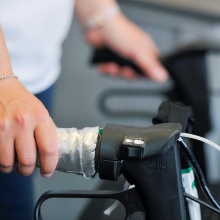Paula Laßmann is a doctoral researcher under Prof. Thomas Maier in the field of technical design at the Institute for Engineering Design and Industrial Design. She has developed a novel adaptive rollator handle. The handle has a silver-colored textile cover, is slightly larger in diameter, and resembles a plump sausage. What makes it special is that it adapts individually to the shape and size of the hand. Laßmann developed the handle especially for seniors.
“Elderly people often don’t have that much strength anymore, or they have bent hands due to arthrosis, so that they cannot grip the handle properly,” the doctoral researcher explains. “The aim is that the rollator handle should react flexibly to hand deformations. It should also adapt when the angle of the gripping hands changes, for example when going uphill or downhill, when getting up or lifting the rollator over the curb,” the young scientist adds. In this way, the force can always be optimally transferred and the pressure on the hand can be evenly distributed.
Coffee - not only good for drinking
The handle feels like a balloon filled with sand. In fact, a self-cast silicone cover, filled with coffee powder, is hidden under the textile cover. Student assistants ground it in their own Thermomix at home. “The advantage of coffee is that we can vary the grinding fineness to achieve the best deformation properties of the handle,” explains Laßmann.
As soon as the hand presses its imprint when gripping the handle, a vacuum pump sucks air out of the handle. This makes the handle firmer and the imprint virtually “freezes”. Sensor strips glued to the silicone cover measure the surface pressure and sound the alarm if it becomes too high. The pump then blows air back into the handle, and the handle can be adapted again - either to a new operating situation or to another user. In addition, a switch on the rollator allows the handle to be adjusted to smaller hands. To do this, a screw drive in a plastic tube inside the handle pushes a kind of stamp outwards. The 13-centimeter elastic silicone handle is thus elongated by a further 3 centimeters and made thinner, so that even smaller hands can optimally clasp the handle.
The idea for such an adaptive handle came from Benedikt Janny, a former doctoral student of the institute, who has since become self-employed with a service startup. “Our institute has been working for some time now on turning parts that can adapt their shape,” says Laßmann.
“Man is made to touch things”
Paula Laßmann, doctoral researcher at the Institute for Engineering Design and Industrial Design
She herself came to the institute three years ago as a research assistant. Initially, Laßmann worked on automated driving trucks. But then Benedikt Janny looked for someone to continue his adaptive-handle project. “During my university studies I developed a lot of user-oriented software, but over time I realized that I prefer to design tangible things. People are made to touch and experience things,” says the cognitive scientist who holds a master’s degree in ergonomics.
When she was still working with Janny, Laßmann successfully raised EUR 40,000 from the university’s own fund for knowledge and technology transfer. The goal: to turn the invention (patent pending) into a product within one year. “Without this funding, we would never have built the adaptive rollator handle in the first place, because we would have lacked the financial means,” says Laßmann.
But there were many challenges in the beginning. The original concept, in which the many mechanical parts could not be installed within the small space, failed. Finally, Laßmann developed the new concept using a coffee powder-filled silicone cover and refined it together with her two student assistants. “The handle works, but it’s still a demonstrator. Now we’ll see if it’s also suitable for mass production,” says Laßmann.
Curbs and ramps as a practical test
Next, the doctoral researcher wants to conduct a user study to find out how the handle proves itself in everyday use As soon as the university reopens after the corona crisis, the project will begin. There are also other things that could be optimized. For example, the power cable for the handle should be replaced by a small battery. And the handle should adapt even faster to changing operating scenarios.
“A lot of capital will be needed to make the handle a marketable product. The easiest way to do this would probably be to find a large company as a partner,” Laßmann says. Funding by the university expired last year. “It would be nice if another funding opportunity for the project came up.” The adaptive handle could be used not only for the rollator, but also for bicycles, wheelchairs, and electrical appliances. “When working overhead, for example with a cordless screwdriver, it would certainly make sense for better force transfer if the handle were adaptive,” the ergonomist explains.
Contact
Paula Laßmann, M. Sc., Institute for Engineering Design and Industrial Design, Department of Technical Design, University of Stuttgart, phone: +49 (0)711 685 66206, E-Mail.




